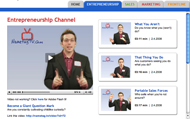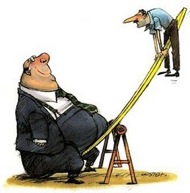 Being human is good for business.
Being human is good for business.
But.
I have no data to measure this.
I have no research to prove this.
I have no statistics to support this.
Nobody does.
Humanizing the workplace is not a process that can be comfortable quantified.
And because of that, most organizations overlook it.
THE GOOD NEWS IS: You don’t need to look very far to find evidence of the profitability of approachability.
THE BAD NEWS IS: There may not be enough evidence to convict you.
Today we’re going to explore a list of ideas for making your organization more human, more approachable and more engaged:1. Learn to be an imperfectionist. Mistakes are a chance to make the company smarter. And if you’re not making them regularly, you’re not risking enough. As I learned in The Magic in Your Mind:
“When imperfectness enters a man’s soul, he is able to show that he does not live alone in the world, but with millions of others, in whose hearts exists the same animating spirit.”
You simply have to be willing to say: “This is me. This is all of me. There is no more. There is no less. Can you accept that?” And if people can’t, get new people. Don’t be the company who never shows any real ugliness.
Instead, boldly flaunt your imperfection. Endorse your own weakness. Not only does make you more human, more relatable and more approachable – it also establishes your acceptance of the imperfect humanness of others. Sounds like a nice place to work to me. Do you trust that your people want the real you?
2. Honor people’s capacity to express. Too many companies work overtime to eliminate employee initiative. And as a protective measure, they ask their people to edit themselves. Probably because they’re terrified of allowing employees to inject their personality into the workplace and, god forbid, be free.
The problem with this command and control approach is that it leads to impersonal, emotionless non-service where employees are objectified and quickly discarded. And nothing could be less approachable.
If you want to humanize the workplace, believe in people enough to let them find their way. Don’t make them feel guilty for their talents. Don’t block the spontaneity that colors their world. Instead of assigning instructions for performing every task, let them breathe. Stop hovering.
Instead, encourage people to suggest improved ways of doing things. That’s how you treat people like people – not like tools to transmit your directions.
Remember: People engage when they have permission to create – not just instructions to comply. How are you letting people live their truth?
3. Empathy is valuable, exertion is priceless. When people come into your office and bleed all over you, the default response is to fire up the empathy engine. Which is smart. Acknowledging people’s feelings, honoring their situation and affirming the courage it takes to share is an approachable, respectful response. And you absolutely want to show people that you care enough to be hurt when they’re upset.
But you also need to care enough to be responsive when they’re in need. Standing knee deep in the gushing rapids of the human condition only matters if you help people get to shore.
My suggestion: Stop empathetically listening to people’s concerns and start immediately acting on them. Remember: Not everyone needs a sound listener – they need a swift exerter. How are you promoting a humanely considerate environment?
4. Be friends, not just amicable strangers. Friendships at work are determined by their utility. We are friends primarily because we are useful to each other. It’s a convenience of mutual accommodation.
Unfortunately, these relationships are merely transactional. And if you want to take intimacy to a higher level, try this: Instead of sitting back and making commentary, try participating in people’s lives. Stamp out anonymity. You don’t need to wear a nametag twenty-four hours a day – but you do need to know that a person’s name is the primary installment of self-disclosure.
Face it: There’s a certain level of intimacy you’ll never achieve if you keep calling people, “buddy” or “big guy.”
My question is: How many people did you go out of your way to ignore yesterday? How many people went out of their way to ignore you yesterday?
Two many. Stop focusing on transactions and start investing in real relationships. Do you like people for who they are or what they give?
5. Be a stand for other people’s greatness. If you want your people to fall in love with you, help them fall in love with themselves first. That’s what being approachable is all about: Not being the life of the party – bringing other people to life at the party. And not solely focusing on who you know – but bragging about whose life is better because they know you.
The secret is to give people a front row seat to their own brilliance. Which is easy to do, considering most people don’t realize how brilliant they are. They’re simply too close to themselves to see it.
Here’s what I do: Be people’s permission slip to be smart. Puncture their delusions of inadequacy. Show them their words have weight by emailing them with notes you took during your last conversation. It’s reflective, respectful, revelatory and reinforcing.
Plus it’s fun. And it proves that recognition isn’t just an interactional gift – it’s an emotional release. If you’re so smart, how come you don’t make other people feel smart?
6. Bear the burden of the human need to belong. That’s what I never understood about immigration law: No human being should ever be illegal. Ever. Last time I checked, we’re all humans – which means we all belong here. Period.
If you want to bolster a sense of belonging, here’ a few ideas:
Invite people before they have to ask. Listen to and actually incorporate people’s ideas. Give people the freedom to do what they believe is right. Prove to people their daily effort isn’t another silent symphony. Reflect people’s thoughts back to them in a way that they feel understood, but not mindlessly repeated. And look people in the eye and, with a fundamentally affirmative attitude, tell them how great their ideas are – no matter how big or small.
Remember: Belonging is the price of admission to people’s hearts. It’s the very oxygen they breathe. And if you don’t make a conscious effort to reinforce it in your organization, people’s loyalty will vanish like a fart in a fan factory. How are you oxygenating the workplace?
7. Root out any sense of entitlement. Here’s where big organizations screw up: They build impenetrable walls to separate the leaders from the people who matter most. And because they’re caught up in rigid identifications at the expense of their humanity, employees rarely work their butts off – much less their hearts out.
Take Zappos, for example. When you take the company tour at their Las Vegas campus, you’ll notice a lack off offices. According to my twenty second conversation with president Tony Tshei:
“We don’t have an open door policy – we have a no door policy.”
Doesn’t get more human than that. And if you want to jolt people awake, try putting hierarchy to sleep. Instead of hologramming your humanity behind the mask of a title, put your person before your position. Values before vocation. Realness before role.
That’s how smart, approachable leaders relax into humility: By releasing their posture of pretense and by staying brave enough to tell people they don’t know everything. How will you keep humility in tact?
REMEMBER: Love is not a combination lock.
If you want to humanize the workplace, you don’t need a formula.
You need to capture heartshare.
You need to treat people like people.
You need to make them feel essential.
That’s how approachability converts into profitability.
LET ME ASK YA THIS…
If your company were charged with the crime of being human, would there be enough evidence to convict you?
LET ME SUGGEST THIS…
For the list called, “10 Unmistakable Motivators of Human Engagement,” send an email to me, and you win the list for free!
* * * *
Scott Ginsberg
That Guy with the Nametag
Author, Speaker, Entrepreneur, Mentor
[email protected]
 Never the same speech twice.
Never the same speech twice.
Now booking for 2011!
Watch The Nametag Guy in action here!

 When I was in college, my roommate and I started a band.
When I was in college, my roommate and I started a band. 
 Approachability is about increasing the probability.
Approachability is about increasing the probability. My business card is a nametag.
My business card is a nametag. 
 Oscar Wilde was right.
Oscar Wilde was right. Being human is good for business.
Being human is good for business.  Welcome!
Welcome! You’ve chosen an uncertain path.
You’ve chosen an uncertain path. You don’t need an idea – you need an
You don’t need an idea – you need an  When I started wearing a nametag everyday, I wasn’t doing it to get attention.
When I started wearing a nametag everyday, I wasn’t doing it to get attention. “I usually refuse to pay for mentoring. But after Scott’s first brain rental session, the fact that I had paid something to be working with him left my mind – as far as I was concerned, the value of that (and subsequent) exchange of wisdom and knowledge, far outweighed any payment.”
“I usually refuse to pay for mentoring. But after Scott’s first brain rental session, the fact that I had paid something to be working with him left my mind – as far as I was concerned, the value of that (and subsequent) exchange of wisdom and knowledge, far outweighed any payment.”